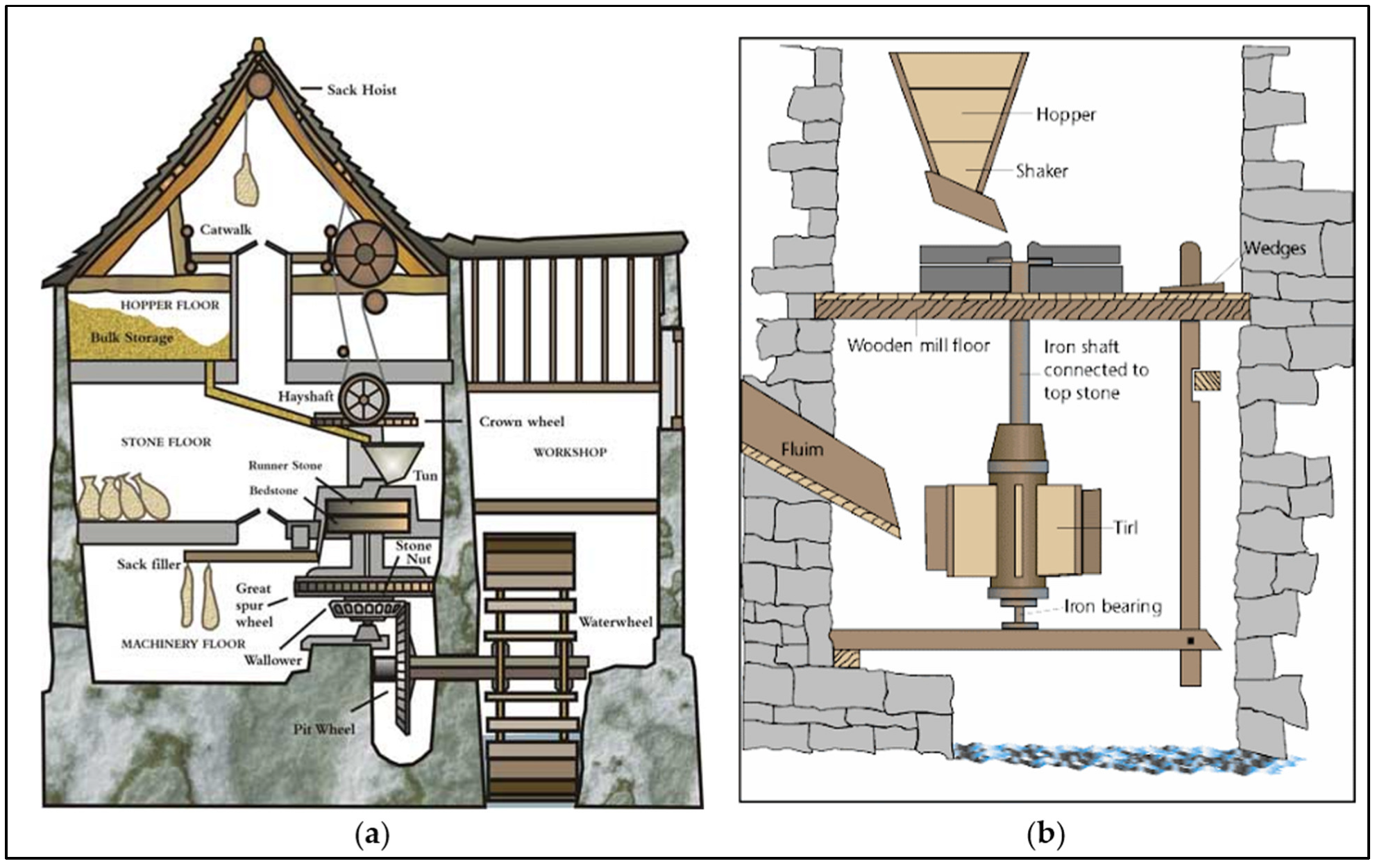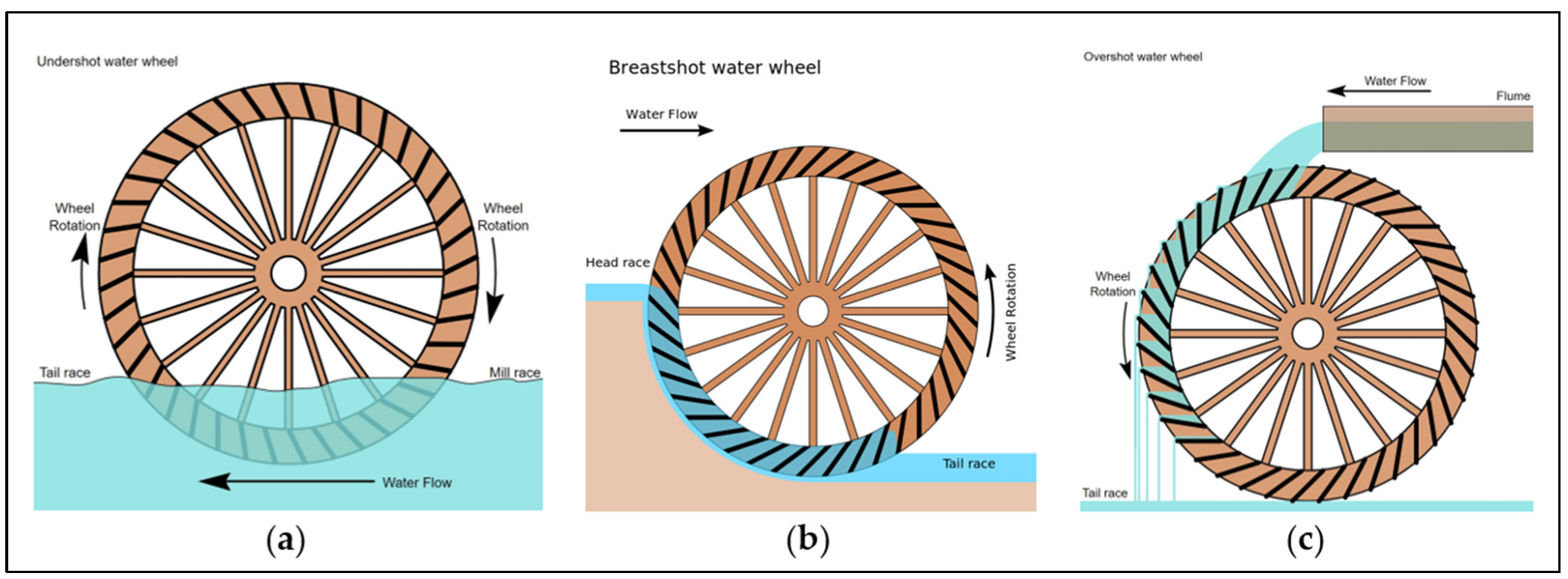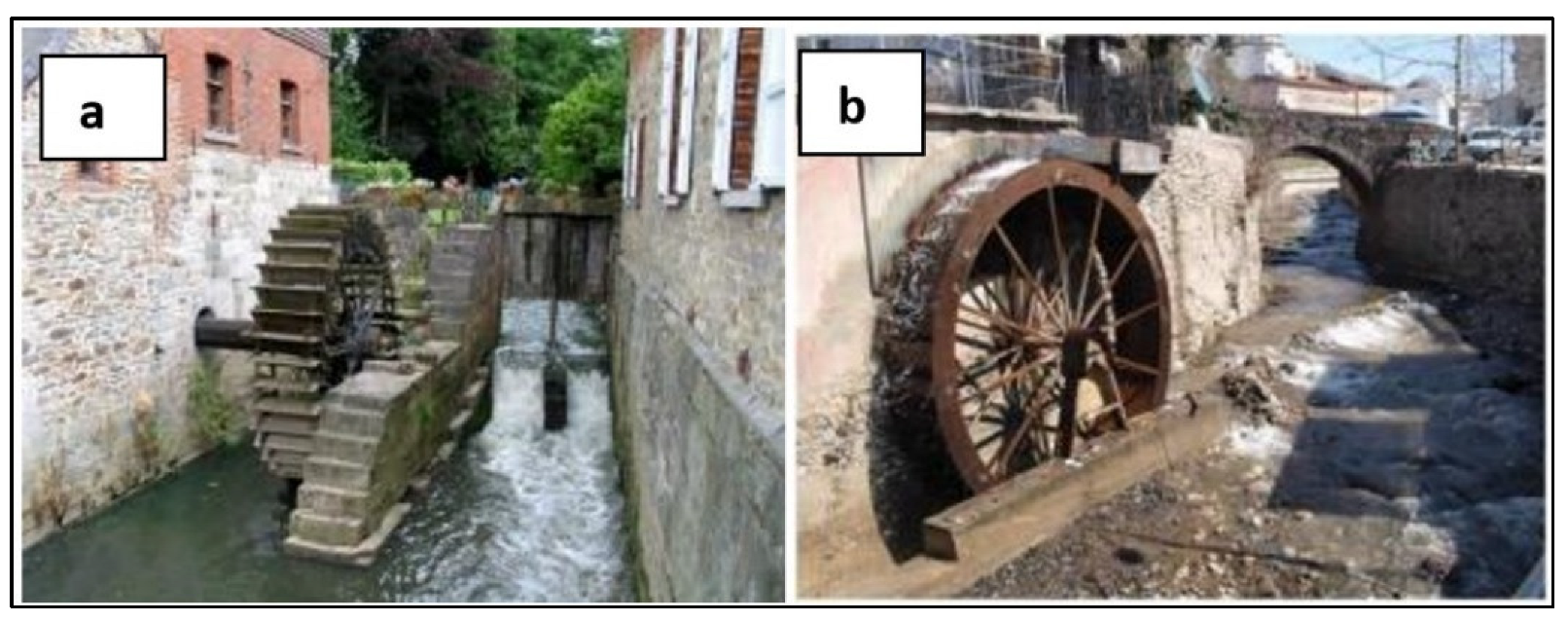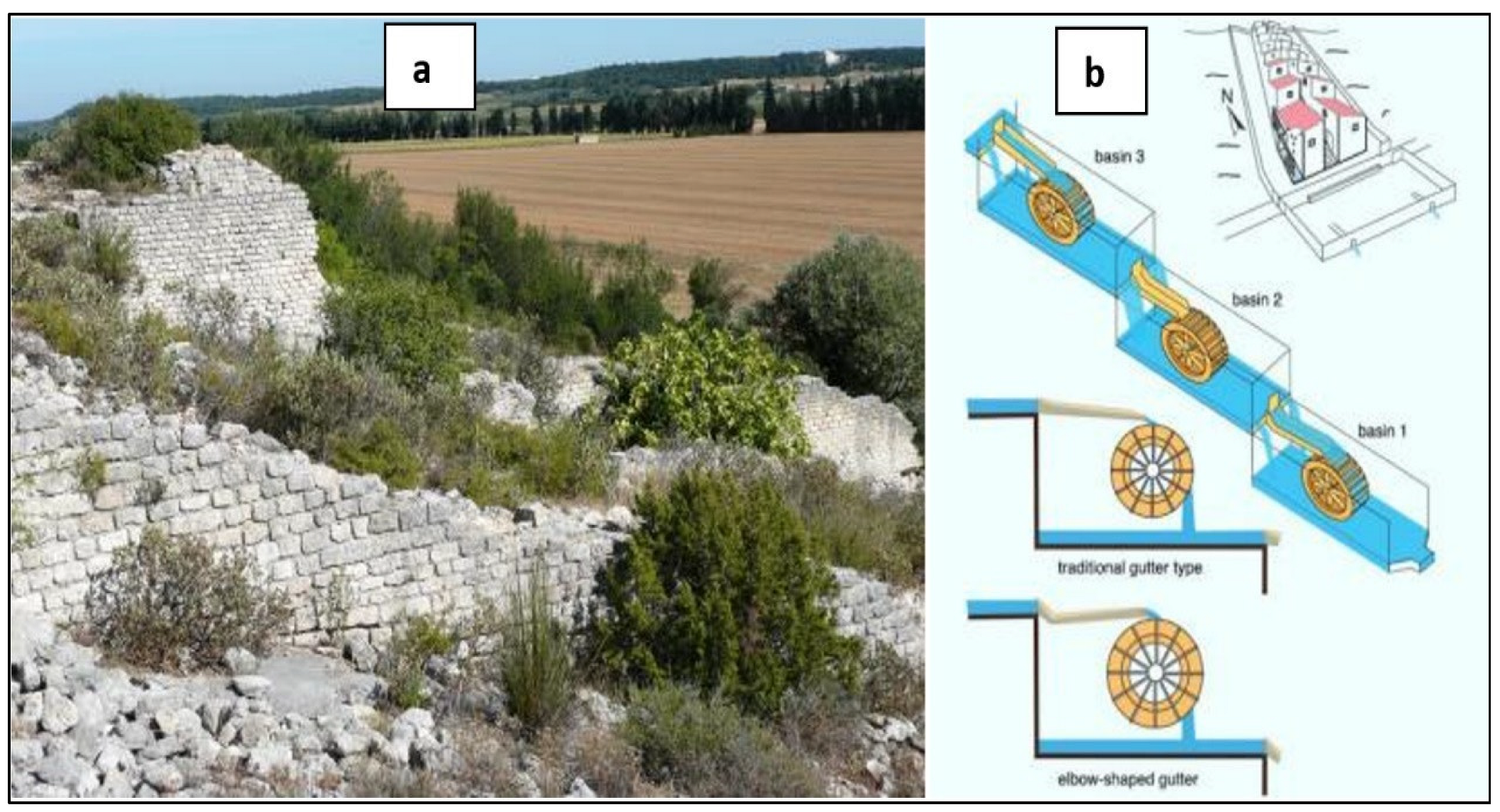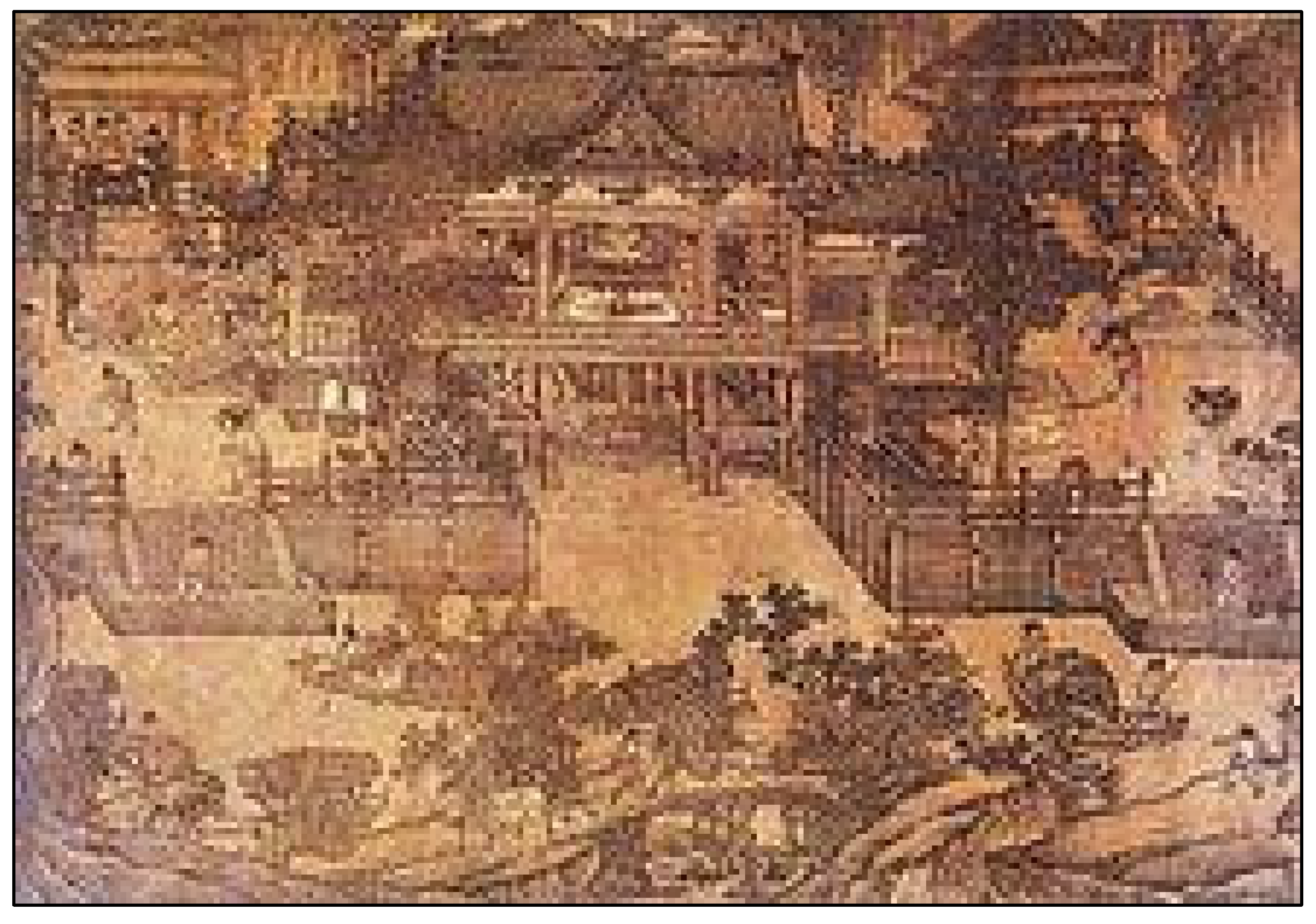1. Introduction
Water mills have a history of almost two millennia as a source of energy, particularly in Europe
[1]. Prior to inventing the first water mill, prehistoric people invented hand-driven grindstones (
Figure 1) used mainly for flour production from grains. During historical times, the original hand-driven grindstones were followed by heavier millstones driven by human and, later, animal power. Thereafter, during the Hellenistic and Roman periods, the two major components of the mill were invented: the water wheel itself and the gearing that powered the water wheel.
Figure 1. Hand-driven grindstones.
The first documented use of water mills was in the 1st century BC, and the technology spread quite quickly across the known world. Commercial mills were in use in Roman times in England, where the existence of more than 6000 water mills late in the 11th century was reported in the Doomsday Book
[2]. By the 16th century, water was the most important source of power in Britain and Europe. The number of water mills probably peaked at more than 20,000 in Europe by the 19th century.
As has already been mentioned, the first appearance of water mills dates back to the end of the Hellenistic period, when the energy generated by humans and animals to rotate the millstones was replaced by that of water. With this innovation, people were able to grind large quantities of cereal seeds and cover the needs of cities in the developing world
[3]. The water mills powered by water were mentioned for the first time by Strabon (64 BC–19 AD), who called them
ydraletas [3]. In addition, it was mentioned that the oldest known water mill was owned by the King Mithridates of Pontus (132–63 BC) in Cabeira.
A water mill is a construction that uses the power of water to turn a wheel or turbine for the mechanical process, such as milling for flour, lumber sawing, or textile production facilities, as well as metal shaping, such as grinding, rolling, or wire drawing, and by using the potential and kinetic energy of water flow, the water mill could rotate a large water wheel.
There are two basic types of water mills: (a) one powered by a vertical water wheel via a gearing mechanism and (b) the other equipped with a horizontal water wheel without a gearing mechanism. The water mill is the first work machine, which was first named neromichani (i.e., water engine), constructed by man for the use of natural, mild, and renewable energy source.
When the first use of a wind mill occurred is unknown although drawings of a water pumping by a wind mill from Persia (current day Iran) exist. This design had vertical sails made of bundles of reeds or wood attached to a central vertical shaft. In practice, in Asia, the water mills fully appeared around the end of the 5th century BC in Persia. The water mill was adopted and expanded by the Romans and was widely spread in the Byzantine Empire and during the Middle Ages in both main types (
Figure 2a,b) according to the position of the water wheel: vertical (Vitruvian), which requires a right-angle gear, and horizontal (Greek or Norse), in which the rotating millstones were attached directly to the same axis
[3], as indicated before. The raw materials used in ancient Greece used to be sandstones or volcanic rocks. There were many locations, e.g., Nisyros, Milos, Santorini, etc., where millstones were quarried and exported to other areas
[3].
Figure 2. Basic types of water mills: (a) powered by a vertical water wheel and (b) equipped with a horizontal water wheel.
The horizontal mill originated in the Near East and showed a very simple mechanical system: The horizontal water wheel is directly connected to the load through a vertical shaft, supported by an axial bearing cooled by the waterpower. This wheel is suitable for mills in rivers with low flow rates and high water velocity due to its height. The average rotational velocity ranges from 15 to 20 rpm.
The mill type powered by vertical water wheels could be further divided into undershot (
Figure 3a), breastshot (
Figure 3b), and overshot (
Figure 3c) depending on the way in which water is supplied. The Vitruvian mill does not need a millrace, dam, or chute. However, the overshot wheel, which required these structures, appeared by the 5th century in Greece. It is possible that the improvement in the Vitruvian mill may have arisen by borrowing the idea of the millrace and chute from the primitive vertical mill. From the last half of the 5th century onwards, the application of the Vitruvian mill became general in Rome and throughout the later Empire, whence it appears to have spread northwards into Germany, probably as a result of the barbarian conquest of Rome. Ultimately, its use spread from there to northern France and England
[4].
Figure 3. Water mills powered by vertical-water wheels could be further divided into: (a) undershot, (b) breastshot, and (c) overshot, depending on the arrangement of water flow.
Water mills are known to have appeared at roughly around the same time in several different regions. The horizontal mill appeared almost simultaneously in the Middle East, Mediterranean Basin, and China between 100 BC and 100 AD. The vertical mill also appeared at roughly around the same time in the Middle East, Mediterranean Basin, and China
[5]. When and where the water wheel originated remains unclear, with various hypotheses regarding its origins.
Water mills are usually built beside streams, rivers, or qanats (an underground hydro-technology to extract water using gravity) used for water supply. Very often, these facilities were improved by the provision of mill races and weirs to help overcome the problems of different seasonal water levels. Many of the weirs seen on rivers today were originally built to help control and keep constant water levels for mills.
The process of ensuring the sustainability of water mill structures and the related restoration techniques will have positive socio-economic impacts
[6]; they will revitalize local villages and economies; encourage the retrofitting of heritage buildings to new uses in rural areas also for promoting socio-economic revitalization in a local level; contribute to the preservation of traditional crafts and activities, thus ensuring the continuation of traditional knowledge as well as stability in rural communities; and contribute to a return in the art of building traditional structures while also maintaining the heritage of rural and vernacular structures.
2. Prehistoric Times
The first real hand-driven stone mill was highly esteemed and used in several places around the globe (e.g., Mesopotamia, Indus Valley, and Minoan Crete) millennia ago. The so-called “saddle stones” were used by kneeling in front of the device, thus employing a back-and-forth method of working
[7]. This device has been in use in various areas of the world (e.g., Central Africa and Central America by natives) since early modern times. The stone mill was initially moved by human power, then animal power, and subsequently by waterpower, as indicated. In addition, the scale of the stone-made mill increased over time.
3. Historical Times
3.1. Classical and Hellenistic Periods’ Devices
The use of waterpower was pioneered by the Greeks: The earliest mention of a water mill during historical times occurs in Homer’s Odyssey (6th century BC), where he describes the grinding of flour as an exclusively women’s issue
[8], as described in the technical treatises
Pneumatica and
Parasceuastica of Philon of Byzantium (ca. 280–220 BC), previously having been regarded as a later Arabic description. However, Wilson
[9] reported that the water mill is of authentic Greek origin.
The chained pump of Philon is a developed form of the
polykadia (divided wheel). Researchers also know it as
mangani. It consists of a chained tape (strip), which has adjusted metallic vessels in its periphery and moves by a rotating wheel
[10]. Since the construction of a wheel of metal was very expensive, soon, the metal was replaced by cheaper materials, such as wood, while the vessels were replaced by ceramics or pumpkins
[11]. This variation is known as “wheel with pots” or “cluster of pots”. The instrument is still used today in many countries.
There is also some evidence that the water mill, the earliest machine harnessing natural forces (other than sailing ships) and as such holding a special place in the history of technology, was invented somewhere between the 3rd and 1st centuries BC
[12][13][14][15]. According to Ahmed
[16], Heron of Alexandria (ca. 1st century BC), a mathematician, physicist and engineer, and director of the Alexandrian Library, was the inventor of the water mill although there are not any ancient references to confirm this suggestion. The Greek culture had spread to many places beyond the mainland (including Alexandria of course), and schools of learning were established in the Near and the Middle East, Palestine, Syria, Anatolia, Mesopotamia, and Persia
[17].
3.2. Roman Period
Vitruvius, in his work on architecture, describes the water mill, while Plinius mentions it as a new machine
[17].
In any case, the water mill was adopted by the Romans and was widely spread in Roman Empire and during the Middle Ages in the previously described types
[12][18][19][20]. Undoubtedly, Heron of Alexandria was really the discloser, if not the inventor, of the water mill as a practical prime mover and was the inspiration for those that followed, even though centuries were probably elapsed between the birth of the idea and its practical application on a large scale. An early water mill still in operation in Niksar, Turkey, is shown in
Figure 4 as well as one in Belgium; both of them were built following ancient technologies.
Figure 4. Early water mills: (a) in Braine-le-Château, Belgium, and (b) in Niksar, Turkey (photos by A.N. Angelakis).
Another example of water mills in the Roman period is the Barbegal water mill complex
[21], constructed in the 2nd century AD in southern France. It represents the earliest and largest known industrial utilization of hydro-technology by an ancient society. The complex, composed of 16 water mills (
Figure 5), has been described as “the greatest known concentration of mechanical power in the ancient world” and has no equivalent either in the Roman world or in Asian civilizations although both are known for their achievements in other fields of hydraulic engineering. Passchier et al.
[22] found that the lower Barbegal water mills used an elbow-shaped flume to bring water onto overshot millwheels. They combined measurements of the water basins with hydraulic calculations and thus were able to show that the flume to which this elbow-shaped piece belonged very likely supplied the mill wheels in the lower basins of the complex with water.
Figure 5. (a) The southern France Barbegal water mill complex; (b) its schematic diagram.
4. Ancient China
During the Han dynasty (ca. 206 BC-220 AD), the Chinese civilization was one of the most brilliant in the world. Han inventions include the water mill (
Figure 6) and the chain pump, which was foot-driven and helped to irrigate the rice fields
[23].
Figure 6. A northern Song era (960–1127 AD) water-powered mill for dehiscing grain with a horizontal wheel.
The traditional watermill was found in China from 30 AD onwards and used to power trip hammers and smelting iron
[24]. The first scientific water mill invented in China in 3rd century BCE (Byzantium). Mr. Du Shi was an inventor (as well as mechanical engineer, metallurgist, and politician of the Eastern Han dynasty) of a water mill applied for hydraulic power for air-blowing devices. The ancient Chinese used water wheels for power for machine operation and irrigation purposes. They used power to transport water about 2000 years ago using the wheel. Ancient Chinese waterwheels stretched into various fields including science, metallurgy, and agriculture.
A famous ancient water mill was found in Lanzhou City in Lanzhou (area of 14,588 m
2), which is an attraction on Binhe Road, with Zhongshan Bridge with Taoist Temple to its south. Water mills (Ming dynasty) made of wood are used for irrigation in the command area of Yellow River. The Chinese traditional waterwheel (dragon-bone wheel) was invented during the Han dynasty
[25]. The horizontal waterwheels was found between 100 BC and 100 AD. The vertical mill was also invented at around the same time in China
[26].


